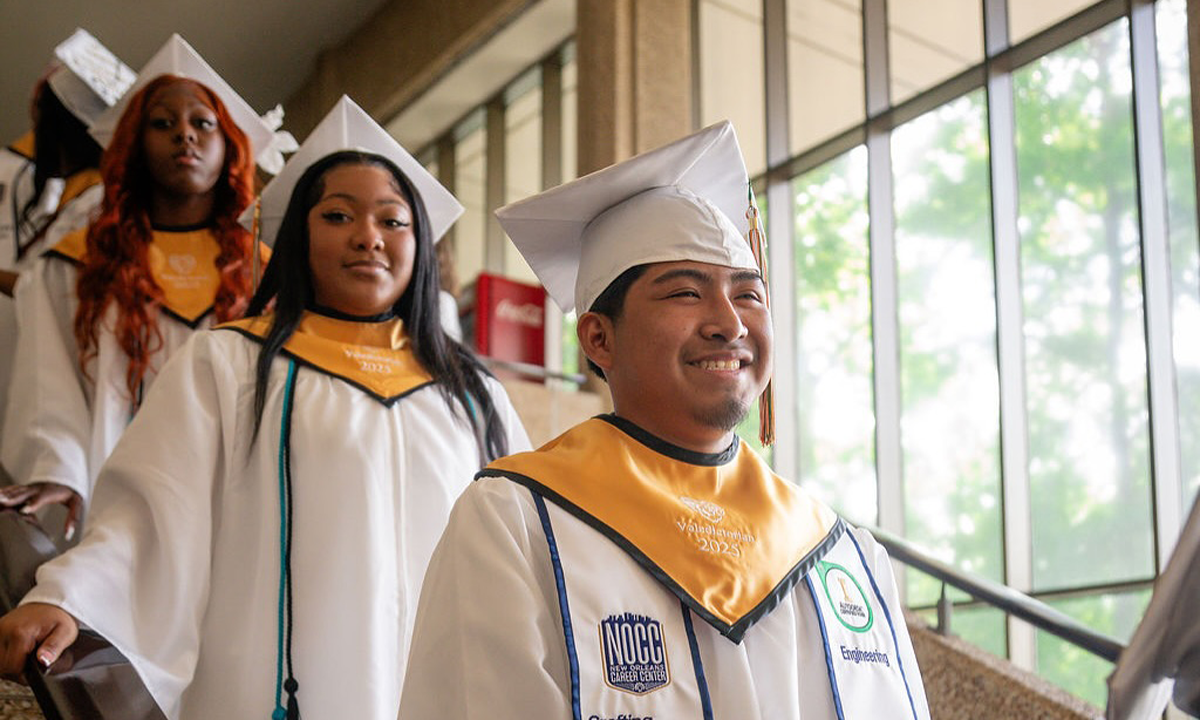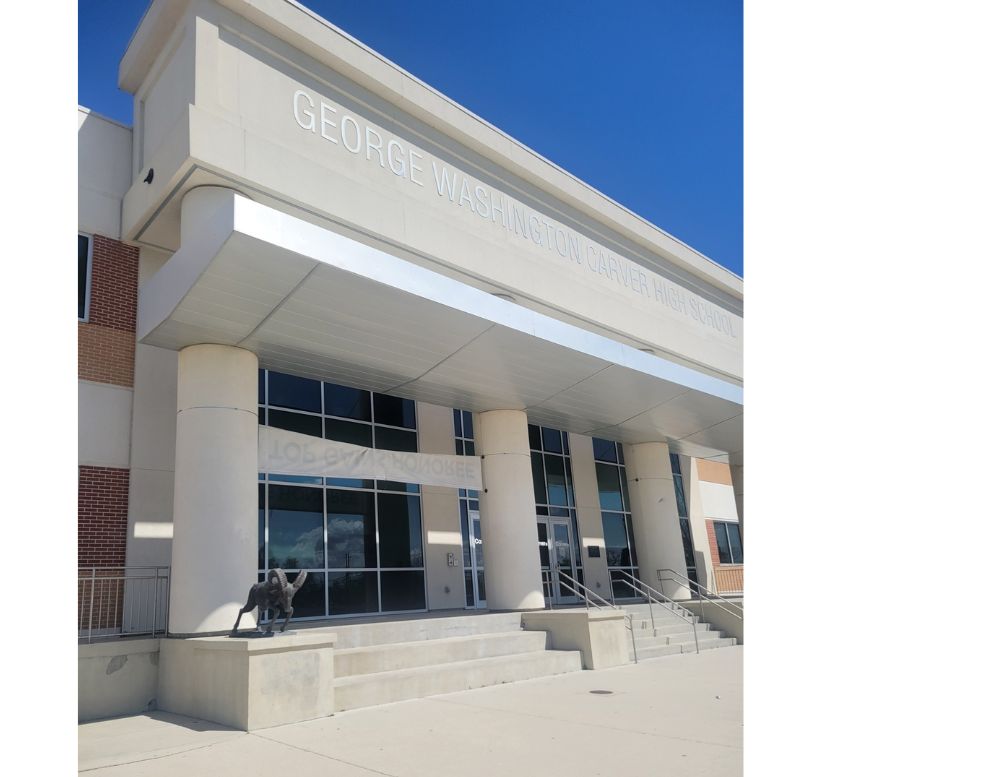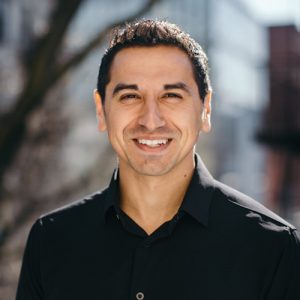The Inconvenient Success of New Orleans Schools
Gupta: How the most dramatic education transformation in modern America became too uncomfortable for anyone to talk about.

Get stories like this delivered straight to your inbox. Sign up for The 74 Newsletter
This is part of a series covering the 20th anniversary of Hurricane Katrina, its effects, and the recovery of New Orleans’ schools. Read all our coverage and essays here.
Twenty years ago, the tragedy of Hurricane Katrina inadvertently created the conditions for one of the most remarkable education experiments in American history. Today, that experiment has quietly produced results that should be making national headlines. Instead, it’s met with a curious indifference that reveals something broken about our politics and media.
To better understand that disconnect, I spent months in New Orleans interviewing more than 50 people about their experience over the past two decades. I heard from both critics and champions of the city’s Katrina recovery reforms: parents, students, teachers, principals, administrators, activists, academics, and common citizens. Their stories are important and illuminating. I even created a whole podcast about them, called Where the Schools Went.
But it’s easy to fall into the tyranny of the anecdote when reporting on fraught education debates like those over the meaning of the New Orleans reforms. So let’s start with the data instead. Hard numbers are more useful than speculation. And the hard numbers from New Orleans are overwhelming.
There’s no one better at parsing the data than Doug Harris, who chairs Tulane’s economics department and directs the Education Research Alliance for New Orleans. Harris has spent years analyzing these outcomes with the kind of methodological rigor that usually prevents education researchers from ever saying anything definitive about anything. His team of advisors includes both reform advocates and skeptics, yet when I spoke with him, Harris offered something virtually unheard of in education research: an unequivocal conclusion. “If you look at any of the typical things that we measure — test scores, high school graduation, college going, college persistence, ACT scores — all of those things are not just better, but quite a bit better than they were before.”
The fine print is striking. When Katrina hit in 2005, roughly 60% of New Orleans schools were labeled “failing” by the state. Today, that number is zero. High school graduation rates have soared from 54% to 78%. College enrollment has jumped by 28 percentage points. Students across all demographics — Black, white, low-income, students with disabilities — have posted dramatic gains that would be the envy of almost any school system in the country.
Harris’s team anticipated and tested the obvious objection: that the student population must have changed after such a massive displacement like Katrina. Perhaps the student body became more affluent? Less needy? They worked with the U.S. Census to track who actually returned, and their finding deflates the skeptics’ favorite excuse: “The demographics of the district changed for families that had school-aged children… almost not at all.” Even more compelling, when they tracked individual students who attended school both before and after Katrina, those same children were learning at faster rates in the new system.
Yet if you scan the national education discourse today, you’d be hard-pressed to find any major elected leaders talking about New Orleans. This represents a dramatic shift. A decade ago, President Barack Obama himself celebrated the city’s progress, telling a New Orleans audience in 2009 that “a lot of your public schools opened themselves up to new ideas and innovative reforms,” and that “we’re actually seeing an improvement in overall achievement that is making the city a model for reform nationwide.”
But that early attention has given way to virtual silence. This silence isn’t accidental — it’s the result of a success story so politically inconvenient that it threatens the foundational beliefs of both sides of America’s education debate.
The Battle of Carver High
To understand why this success story became politically radioactive, look no further than George Washington Carver High School. Originally built in the 1950s as one of the city’s first high schools for Black students, Carver embodied the flawed promise of separate-but-equal education. By the 1990s, it had become what historian Walter Stern called an “educational Soweto” — a struggling school in a neglected neighborhood with graduation rates hovering around 50% and repeated failing grades from the state.

Then Katrina destroyed both the school and its surrounding Ninth Ward community. Karl Washington, a Carver alumnus, remembered the aftermath: “That area received eight, nine feet of water. It wiped out everything: the community footprint, businesses, spirit.” But the alumni were determined to rebuild Carver.
The state agreed, but then came the question of who would run it. The alumni community had their vision: a return to the Carver they remembered, with its proud traditions of football, marching band, and community connection.
The state had different ideas. Instead of awarding the charter to community leaders, officials chose Collegiate Academies, an organization founded by Ben Marcovitz, a Harvard graduate from Washington, D.C., who had achieved remarkable academic results at his Sci Academy charter school campus. Marcovitz’s schools were data-driven, disciplined, and relentlessly focused on college preparation. They were also run primarily by young, white outsiders through programs like Teach for America.

This staffing approach was particularly inflammatory given what had happened to New Orleans teachers after Katrina. When the district ran out of money, all 7,500 employees — including every teacher in the city — were laid off en masse. Most were never rehired. Many of these teachers were Black women who had been pillars of the city’s middle class for decades. They had deep roots in the communities they served. To see them replaced by young, college graduates, many of them white, with minimal teaching experience (and no union contract) felt like salt in an open wound. I explore this painful history in Episode 3 of Where the Schools Went.
The backlash to the state’s Carver plans was immediate and fierce. Chris Meyer, a state official tasked with explaining the decision, recalled arriving to find “a human chain in front of the building” and protesters blocking the entrance. After managing to get inside, “I get two words, maybe three outta my mouth, and the whole meeting just erupts in chaos.” When Meyer left the meeting, he found his car windows smashed, with glass scattered across his child’s car seat.
Jerel Bryant, the Yale-educated principal chosen to lead the new Carver, walked into this firestorm. His team quickly produced strong academic results, posting some of the best algebra scores in the city. But the achievement felt hollow amid growing community resistance.
The breaking point came in December 2013, when 60 students walked out in protest. They were frustrated by what they saw as excessive discipline: having to walk on taped lines in hallways, getting suspended for chewing gum or wearing the wrong shoes. One student told reporters: “You get suspended for coughing. You get suspended for sneezing out loud.”
The Southern Poverty Law Center criticized the school’s suspension rates. Three parents publicly withdrew their children, though the vast majority stuck with the program. Local newspapers published side-by-side graphics showing Carver’s academic gains alongside its suspension statistics, as if to ask: At what cost?
For critics of education reform, this was the perfect story: test scores rising through harsh discipline and cultural suppression. For supporters, it was proof that change inevitably faces resistance, even when it’s working. The battle lines were clear, the rhetoric heated, and the national media seized on the drama. The Atlantic ran not one but two major pieces on Carver’s discipline policies. The Hechinger Report called it “the painful backlash against ‘no-excuses’ school discipline.”
But then something unexpected happened.
The Quiet Revolution
Had I visited Carver 10 years ago and stopped my reporting there (as many national outlets have), this would be a very different story — one that fit neatly into our national education wars. But over the past decade, something remarkable happened.
By 2014, Carver’s principal and his team began to listen more carefully to their critics. “Even when I didn’t agree with their tone or tactics or priorities,” Bryant reflected, “I didn’t doubt that they wanted the school to be great. And finding that common ground—that’s the challenge, and the opportunity.”
The school began implementing what educators call “restorative practices”—mediations and healing circles instead of suspensions. They trained staff differently, built new programs, funded the marching band, and hired more teachers from the community. Most importantly, they connected these changes to their core mission rather than treating them as distractions from it.
@marchingtrend 🔥This version of “Flowers” by Miley Cyrus is so powerful! 💥 George Washington Carver Highschool Marching Band from New Orleans🔥 #HBCU 🎺 level up! 🎥: dright.the.king.of.oneself #marchingband #highschool #music #marchingtrend #schoolband #band #marchingmusic #instagram #love #art #flowers #brass #drums #instagood #mileycyrus #cover #international #reelsinstagram #usa #drumcorps #viralvideo #worldwide #shorts #worldwide #neworleans #highschoolband #school #band #tiktok #facebook #flowers🌸 ♬ original sound – marchingtrend
“Strong sports teams help with suspension rates,” Bryant explained. “Engaging lessons help with suspension rates. Connecting before you correct, that helps too. A kid has to really believe: I want to be part of this. Otherwise, we lose a powerful lever to change behavior.”
The results were dramatic. Suspension rates dropped by nearly two-thirds in a single year. But rather than hurting academic performance, the changes seemed to enhance it. Last year, Carver earned an A for academic growth from the state and ranked second among all open-enrollment high schools in New Orleans for students achieving mastery on state exams. The year before, they had the highest academic growth in the state. Oh, and their boys’ basketball team? They’ve been to three straight state championship games and won back-to-back titles in 2022 and 2023.

When I visited the school this spring, the transformation was evident everywhere. The trophy case displayed sports trophies and homecoming photos alongside college acceptance letters. The staff was older, more rooted in the community, and included several Carver alumni who had returned as teachers and coaches. Even Sandra, who works in the cafeteria, glowed when talking about the school: “The teachers? Marvelous. The principal? Excellent. Everybody here is loving and kind.”
Eric French, the band director and Carver alumnus, broke down crying when describing what it meant to return to his alma mater: “It was like a dream come true. When I walked into the interview, I almost broke down. I knew if I could just get my foot in the door, it would be up from there.”
Nell Lewis, the school’s director of culture, had lived through the entire transition: “The community didn’t believe at first. They saw white folks, outsiders, people who didn’t understand. But now they see the results. We didn’t used to have academic success here. We had championships, but not college. Not like now.”
Of course, cafeteria workers praising their workplace and band directors getting emotional about their alma mater don’t generate the same headlines as student walkouts and community protests. Collaboration doesn’t click like conflict. Which helps explain why the current New Orleans story — technocratic problem-solving, gradual improvement and former adversaries working together — has been largely ignored by those who thrive on drama and division.

The Systemwide Evolution
What happened at Carver was part of a broader evolution occurring across New Orleans. In the immediate aftermath of Katrina, the city had operated what could charitably be called an “anti-system” — dozens of autonomous charter schools with little coordination or oversight. This approach produced impressive academic gains but also created chaos for families trying to navigate wildly different enrollment processes, discipline policies and academic calendars.
By 2012, state leaders began implementing what they called “systems building.” They created OneApp, a centralized enrollment system that gave families one application for all schools citywide. They established common discipline policies and centralized expulsion hearings to prevent schools from pushing out challenging students. They developed a weighted funding formula that sent more resources to schools serving students with greater needs.
Most importantly, they approached these changes collaboratively. Rather than mandating from above, the Recovery School District convened school operators to build consensus around shared systems. The result was something unprecedented in American education: a system that preserved school-level autonomy while creating citywide coherence around the functions that mattered most for equity and access. Schools could still choose their own curriculum, pedagogical approach, and staffing model. But they couldn’t cherry-pick students, ignore due process for discipline, or operate in isolation from families’ needs.
The Uncomfortable Truth
This evolution produced a model that should theoretically appeal to both sides of America’s education debates. It delivered the academic results that reformers promised while addressing the equity and community concerns that critics raised. It proved that choice and accountability could coexist with collaboration and local input.
Instead, it has been met with bipartisan silence.
For progressives, acknowledging New Orleans’s success would require confronting some uncomfortable truths. The Katrina recovery transformation was built on the elimination of teacher tenure, the dissolution of union contracts and the replacement of neighborhood school assignments with choice-based enrollment (subjects we cover at length in episodes 3 and 4 of Where the Schools Went). These are precisely the policies that national Democratic leaders now oppose.
President Joe Biden has called himself “not a charter school fan.” Sen. Elizabeth Warren warns that charter expansion “strains the resources of school districts and leaves students behind.” The party has increasingly embraced a defensive posture that treats any deviation from the traditional district model or unequivocal support for teachers’ unions as an attack on public education itself.
But the old, pre-Katrina New Orleans had all the elements that progressives now champion as essential: a powerful teachers’ union, centralized administration, neighborhood school assignments and an elected school board. It also had some of the worst educational outcomes in the country.
For conservatives, the New Orleans model presents an equally uncomfortable problem. The city’s success came not through pure market forces but through a limited but aggressive government intervention. The state stepped in to close failing schools, coordinate enrollment, standardize discipline policies and redistribute resources based on student needs. They also relied heavily on government-mandated standardized testing to gauge school quality. This is hardly the small-government, laissez-faire approach that conservative education reformers typically champion.
Moreover, if more districts could become as responsive and effective as New Orleans, there would be less demand for the private school vouchers and education savings accounts that have become conservative orthodoxy. Why abandon public education if it can actually work?
The media, meanwhile, has moved on to more sensational stories. The current New Orleans narrative doesn’t generate clicks or cable news debates. It’s the educational equivalent of reporting on a well-functioning water treatment plant: critically important but insufficiently dramatic for our attention economy.
The Lessons We’re Ignoring
This silence comes at a significant cost. New Orleans offers genuine lessons for other cities struggling with educational inequity, not as a perfect model to replicate but as proof that dramatic improvement is possible when leaders are willing to experiment, listen and adapt.
The city’s approach suggests a middle path between the extremes that have dominated education debates: neither the rigid centralization that characterized many urban districts nor the unchecked autonomy that marked early charter experiments. Rather it demonstrates what former state superintendent John White called “coherence” — clear communication and a well-articulated philosophy around what government should control and what schools should decide for themselves.
“You attracted some great people, many from within the system, many from without,” White explained. “You held them very accountable for doing their jobs. You resourced them proportionate to the challenges, and you set very clear boundaries around what you were gonna be involved with and what you weren’t gonna be involved with.”
This approach could work in districts with or without charter schools, with or without choice programs. It’s fundamentally about governance: being strategic about where to centralize and where to decentralize, building systems that support both equity and excellence, and creating space for both innovation and accountability.
A Model for Politics
Perhaps most importantly, New Orleans demonstrates something that feels almost impossible in our current political moment: the capacity for opposing sides to actually listen to each other and change course based on what they learn.
The reformers who dismissed community concerns about culture and representation gradually recognized that academic success without community buy-in was unsustainable and immoral. The community leaders who initially rejected any changes to traditional approaches came to appreciate that good intentions weren’t enough if children weren’t learning.
This wasn’t compromise for its own sake but genuine evolution based on evidence and experience. Today, many of the harshest critics of early reform efforts acknowledge the system’s improvements while continuing to push for better. Many reform leaders have become more sophisticated advocates for equity and community engagement.
As education advocate Chris Stewart, who grew up in New Orleans, put it: “We want to be transparent, but not loud. New Orleans should keep doing what they’re doing. They should keep winning and improving. But it doesn’t help to nationalize their story anymore.”
Perhaps Stewart is right that New Orleans benefits from flying under the national radar. But the rest of the country pays a price for ignoring what’s happened there. In an era when Americans seem incapable of finding common ground on any contentious issue, New Orleans offers a rare example of adversaries becoming collaborators, of ideology yielding to evidence, of a community choosing pragmatic progress over perfect ideological purity.
That’s a lesson worth learning, even if it makes everyone a little uncomfortable.
Get stories like these delivered straight to your inbox. Sign up for The 74 Newsletter

;)
